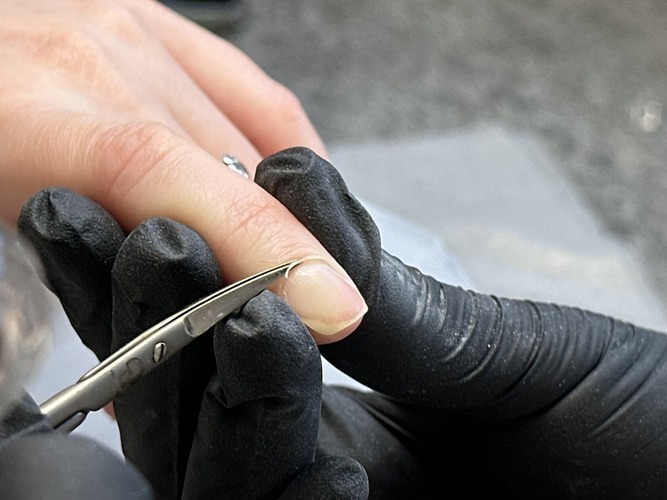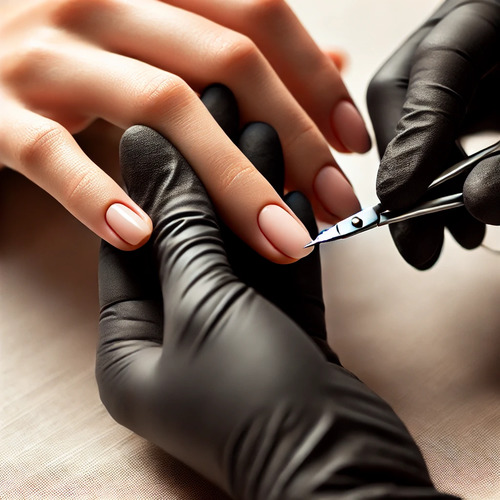The cuticle is an integral part of the nail that fulfils an important protective function and plays a key role in nail health. It can be either healthy or problematic, so choosing the right manicure for each type of cuticle is of paramount importance.
How to work with dry cuticles?

Dry cuticles can be a serious challenge for the wearer. Not only is the cuticle less protective of the area around the nail, but it also increases the risk of hangnails, which can lead to inflammation and even fungal diseases. In addition, dry cuticles give the nails an ungroomed look.
The manicurist must be especially careful when caring for dry cuticles. Cutting cuticles is not recommended, as the use of scissors or tweezers can damage the delicate skin around the nail. Due to the presence of capillaries near the cuticle, there is a risk of ‘bleeding’, which is not only painful but can also lead to infections. Instead, it's worth using gentle grooming methods such as moisturising and massage to keep your cuticles and nails healthy overall.
The most effective method of dealing with dry cuticles is a machine manicure. A cutter can be used to gently remove pterygium without damaging the sensitive cuticle. This technique gently polishes the keratinised skin, keeping it healthy and preventing injury.
Specialised oils are recommended to prevent further drying of the cuticle. Organic products based on sweet almond and jojoba oils, as well as moisturising creams are excellent options. It is also important to remind the client to avoid contact with chemicals and hard water without gloves, as such an aggressive environment is one of the main factors contributing to dry nails and cuticles.
In addition, dryness can be caused by internal factors such as stress, poor diet or taking certain medications.
How to deal with wet cuticles?
Wet cuticles can be associated with hyperhidrosis of the hands, which is manifested by increased skin elasticity. Therefore, cuticle removal should be done with extreme care, as wet cuticles are easily torn by sloppy handling.
The most effective treatment for wet cuticles is a combination manicure. It is recommended to dry the cuticle thoroughly before removing it, which will make it easier to remove the keratinised skin. After drying, the cuticle can be gently pushed back with a poucher and the pterygium can be cleaned with a special cutter.
When using the cutter, proceed carefully, lifting the wet cuticle to make it easier to cut with manicure scissors. At the end of the procedure, the cuticle and side rollers are polished with a soft corundum nozzle, giving the nails a smooth and neat look.
How to work on thinning cuticles?
A thinning cuticle can build up on the nail plate and crack over time, which not only worsens the appearance of the nails, but can also lead to inflammation or infection. Therefore, special attention to this area is extremely important!
During a manicure, the raised cuticle is carefully treated with a cutter, the pterygium is cleaned, and the side rollers are polished. It is important to carefully trim the cuticle with manicure scissors or tweezers along the growth line so that it grows properly in the future.
Between manicure sessions, clients can care for their cuticles at home. It is recommended to gently push back the cuticle with an orange stick, pre-moistened with special oil. This procedure helps to keep your nails healthy and prevent excessive cuticle growth.
How to work with dense cuticle?

If the cuticle is very dense, working with it can cause discomfort for the master, and sometimes even lead to sweating. In such cases, a European manicure, which does not involve cutting the cuticle, may be sufficient. However, not all masters manage to neatly push back the cuticle, which can leave the client dissatisfied with the result. An effective solution can be a combination of cuticle removal and the European method.
It is recommended to use a special cuticle remover. Apply the cuticle remover and leave it on for a few minutes - the exact time depends on the composition of the product. During this time, the keratinised skin will become thinner and the roughest areas can be easily trimmed. The remaining cuticle should be gently pulled back with an orange stick or poucher.
To soften coarse cuticles, it is important to regularly apply peach cuticle oil. This practice not only improves the appearance of the cuticle, but also promotes overall nail health.
How to repair damaged cuticles?
Not all clients are able to keep the skin around their nails in perfect condition. Due to injury, illness or bad habits, the skin around the nail plate can become damaged, causing hangnails, cracks and even ulcers. Therefore, the manicurist needs to approach such care with special care and attention.
Damaged cuticles require delicate care, and their treatment is safest performed as part of a classic manicure. Hardware manicure is not suitable here, as it can further traumatise the skin. If there are any open wounds on the skin, treat the area with an antiseptic before starting the manicure. Cuticle removal with manicure scissors is a safe and gentle method that provides quality care for damaged skin.
To accelerate healing, it is recommended to use natural oils enriched with vitamins, specially designed to restore sensitive skin. They will help moisturise and soften the cuticle, promoting its healing. After the procedure, it is worth advising the client to visit a dermatologist. The specialist will be able to conduct a deeper diagnosis of the skin condition and prescribe a suitable treatment. After all, health is the basis of beautiful, well-groomed hands!
